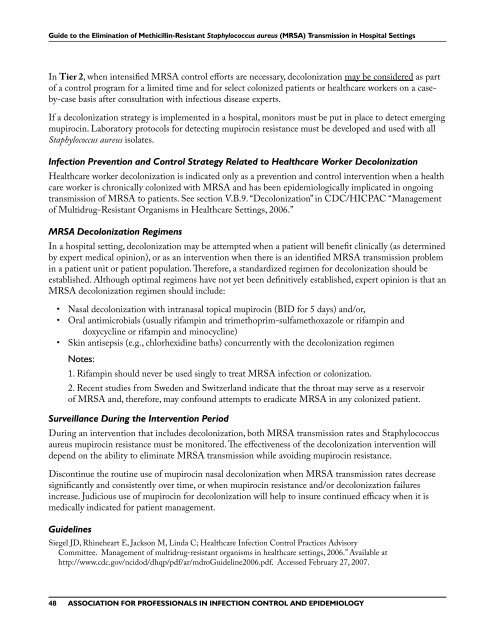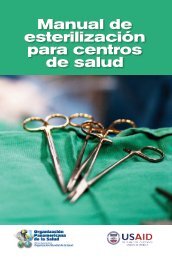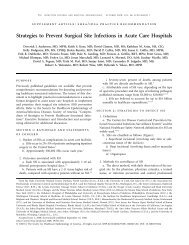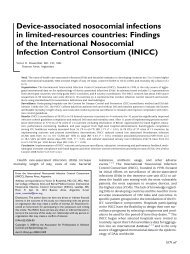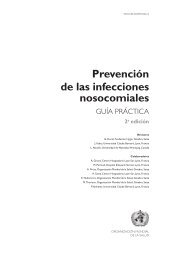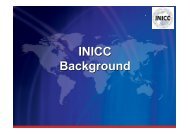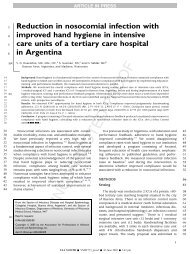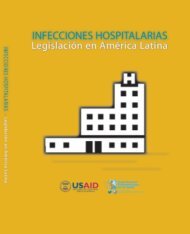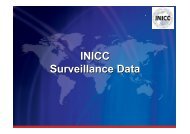Guide to the <strong>Elimination</strong> of Methicillin-Resistant Staphylococcus aureus (<strong>MRSA</strong>) Transmission in Hospital SettingsIn Tier 2, when intensified <strong>MRSA</strong> control efforts are necessary, decolonization may be considered as partof a control program for a limited time and for select colonized patients or healthcare workers on a caseby-casebasis after consultation with infectious disease experts.If a decolonization strategy is implemented in a hospital, monitors must be put in place to detect emergingmupirocin. Laboratory protocols for detecting mupirocin resistance must be developed and used with allStaphylococcus aureus isolates.Infection Prevention and Control Strategy Related to Healthcare Worker DecolonizationHealthcare worker decolonization is indicated only as a prevention and control intervention when a healthcare worker is chronically colonized with <strong>MRSA</strong> and has been epidemiologically implicated in ongoingtransmission of <strong>MRSA</strong> to patients. See section V.B.9. “Decolonization” in CDC/HICPAC “Managementof Multidrug-Resistant Organisms in Healthcare Settings, 2006.”<strong>MRSA</strong> Decolonization RegimensIn a hospital setting, decolonization may be attempted when a patient will benefit clinically (as determinedby expert medical opinion), or as an intervention when there is an identified <strong>MRSA</strong> transmission problemin a patient unit or patient population. Therefore, a standardized regimen for decolonization should beestablished. Although optimal regimens have not yet been definitively established, expert opinion is that an<strong>MRSA</strong> decolonization regimen should include:• Nasal decolonization with intranasal topical mupirocin (BID for 5 days) and/or,• Oral antimicrobials (usually rifampin and trimethoprim-sulfamethoxazole or rifampin anddoxycycline or rifampin and minocycline)• Skin antisepsis (e.g., chlorhexidine baths) concurrently with the decolonization regimenNotes:1. Rifampin should never be used singly to treat <strong>MRSA</strong> infection or colonization.2. Recent studies from Sweden and Switzerland indicate that the throat may serve as a reservoirof <strong>MRSA</strong> and, therefore, may confound attempts to eradicate <strong>MRSA</strong> in any colonized patient.Surveillance During the Intervention PeriodDuring an intervention that includes decolonization, both <strong>MRSA</strong> transmission rates and Staphylococcusaureus mupirocin resistance must be monitored. The effectiveness of the decolonization intervention willdepend on the ability to eliminate <strong>MRSA</strong> transmission while avoiding mupirocin resistance.Discontinue the routine use of mupirocin nasal decolonization when <strong>MRSA</strong> transmission rates decreasesignificantly and consistently over time, or when mupirocin resistance and/or decolonization failuresincrease. Judicious use of mupirocin for decolonization will help to insure continued efficacy when it ismedically indicated for patient management.<strong>Guideline</strong>sSiegel JD, Rhineheart E, Jackson M, Linda C; Healthcare Infection Control Practices AdvisoryCommittee. Management of multidrug-resistant organisms in healthcare settings, 2006.” Available athttp://www.cdc.gov/ncidod/dhqp/pdf/ar/mdro<strong>Guideline</strong>2006.pdf. Accessed February 27, 2007.48ASSOCIATION FOR PROFESSIONALS IN INFECTION CONTROL AND EPIDEMIOLOGY
Guide to the <strong>Elimination</strong> of Methicillin-Resistant Staphylococcus aureus (<strong>MRSA</strong>) Transmission in Hospital SettingsBorlaug G, Davis JP, Fox BC. Community Associated methicillin-resistant Staphylococcus aureus: guidelines for clinicalmanagement and control of transmission. Wisconsin Division of Public Health; October 2005.Infectious Disease Society of America (IDSA). Practice guidelines for the diagnosis andmanagement of skin and soft-tissue infections. Clin Infect Dis. 2005;41:1373-1406. Available athttp://www.journals.uchicago.edu/CID/journal/issues/v41n10/37519/37519.html. Accessed February 27, 2007Journal articles and reviewsNicholson MR, Huesman LA. Controlling the usage of intranasal mupirocin does impact the rate of Staphylococcus aureusdeep sternal wound infections in cardiac surgery patients. Am J Infect Control. 2006;34:44-48.Perl T. Prevention of Staphylococcus aureus infections among surgical patients: Beyond traditional perioperative prophylaxis.Surgery. 2003;134:S10-S17.Konvalinka A, Errett L, Fong IW. Impact of treating Staphylococcus aureus nasal carriers on wound infections in cardiacsurgery. J Hosp Infect. 2006;64:162-168.Loeb M, Main C, Walker-Dilks C, Eady A. “Antimicrobial drugs for treating methicillin-resistant Staphylococcus aureuscolonization.” Cochrane Library review of six decolonization studies: no evidence to support nasal or extra-nasaldecolonization. http://www.mrw.interscience.wiley.com/cochrane/clsysrev/articles/CD003340/frame.html (Date of lastsubstantial Update: August 25, 2003). Accessed February 27, 2007Simor AE, Phillips E, McGeer A, et al. Randomized controlled trial of chlorhexidine gluconate for washing, intranasalmupirocin, and rifampin and doxycycline versus no treatment for the eradication of methicillin-resistant Staphylococcusaureus colonization. Clin Infect Dis. 2007;44:178-185.Henderson DK. Managing methicillin-resistant staphylococci: a paradigm for preventing nosocomial transmission ofresistant organisms. Am J Med. 2006;119(6 Suppl 1):S45-S52.Deshpande LM, Fix AM, Pfaller MA, Jones RN; SENTRY Antimicrobial Surveillance Program Participants Group.Emerging elevated mupirocin resistance rates among staphylococcal isolates in the SENTRY AntimicrobialSurveillance Program (2000): correlations of results from disk diffusion, Etest and reference dilution methods. DiagnMicrobiol Infect Dis. 2002;42: 283-290.Practice ToolsThe following (Table 3.) is an example from the U.S. Navy and Marine Corps of a decolonizationregimen that may be used if clinically indicated. It can be accessed in “<strong>Guideline</strong>s forthe Management of Community-Acquired Methicillin-Resistant Staphylococcus aureus(CA-<strong>MRSA</strong>) Infections in the U.S. Navy and Marine Corps”; May 2005. Available athttp://www-nehc.med.navy.mil/Downloads/prevmed/CPG_<strong>MRSA</strong>_20050516_final.pdf.TABLE 3. Regimen for Decolonization.MupirocinChlorhexidine*• Apply approximately one-half of 2% calcium muciprocin ointment from the 1 gm single-use tube(Bactroban®) into one nostril and the other half of the ointment to the other nostril.• The individual should press the sides of the nose together and gently massage to spread theointment throughout the inside of the nostrils.• Continue twice daily for 10 days, avoiding contact of the medication with the eyes. 24• Rinse area thoroughly with water, avoiding excessively hot or cold water.• Wash gently from the neck down with the minimum amount of Hibiclens® as necessary.• Rinse thoroughly with warm water.• Continue one daily for 5 days.*Hibiclens®, containing 4% chlorhexidine gluconate, is known to be toxic. The manufacturer provides the followingprecautions when using Hibiclens®: Hypersensitivity reactions may occur, particularly in the genital area. Keep away fromface andhead, since middle ear contact has lead to deafness and permanent eye injury may occur following prolonged contact.ASSOCIATION FOR PROFESSIONALS IN INFECTION CONTROL AND EPIDEMIOLOGY 49


